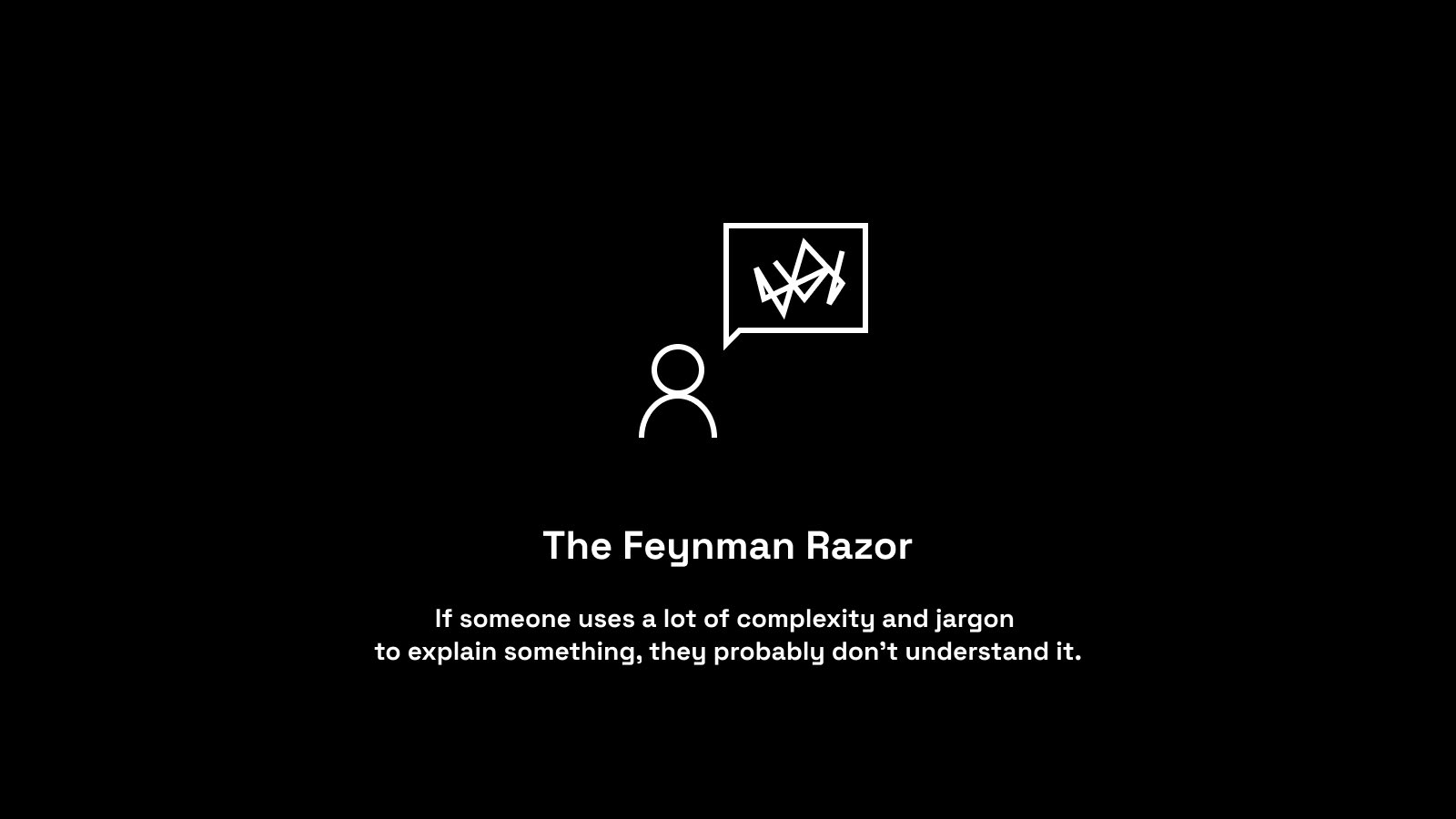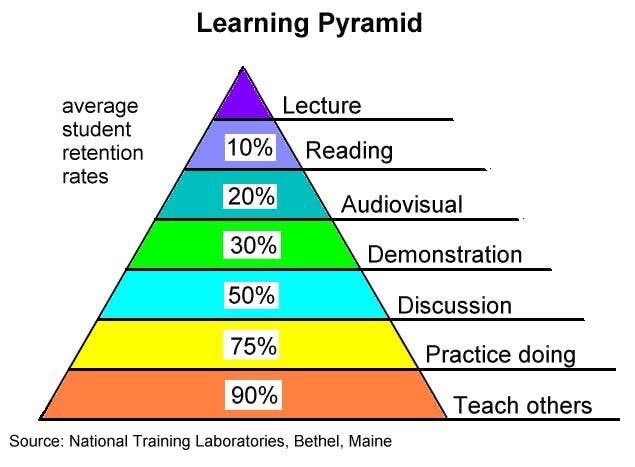Thread
The Feynman Technique is a learning method that prioritizes simplicity to build depth of understanding.
It takes its name after Richard Feynman—an American theoretical physicist who won the Nobel Prize in 1965 for his groundbreaking work in quantum electrodynamics.
It takes its name after Richard Feynman—an American theoretical physicist who won the Nobel Prize in 1965 for his groundbreaking work in quantum electrodynamics.
Richard Feynman was certainly intelligent.
But there are a lot of intelligent people in the world.
Feynman's true genius was noted as his ability to convey complex ideas in simple, elegant ways.
But there are a lot of intelligent people in the world.
Feynman's true genius was noted as his ability to convey complex ideas in simple, elegant ways.
He observed that complexity and jargon are often used to mask a lack of deep understanding.
Hence “The Feynman Razor” that I’ve written about:
If someone uses a lot of complexity and jargon to explain something to you, they probably don’t understand it.
Hence “The Feynman Razor” that I’ve written about:
If someone uses a lot of complexity and jargon to explain something to you, they probably don’t understand it.
The Feynman Technique is a learning framework that requires you to develop a deep understanding of a given topic.
It involves four key steps:
1. Set the Stage
2. ELI5 (Explain It To Me Like I'm 5)
3. Assess & Study
4. Organize, Convey & Review
Let's cover each step:
It involves four key steps:
1. Set the Stage
2. ELI5 (Explain It To Me Like I'm 5)
3. Assess & Study
4. Organize, Convey & Review
Let's cover each step:
Step 1: Set the Stage
What’s the topic you want to learn?
Starting with a blank page, write the topic at the top and jot down everything you know about it.
Read & research the topic.
Add any new learnings or insights as you develop them.
What’s the topic you want to learn?
Starting with a blank page, write the topic at the top and jot down everything you know about it.
Read & research the topic.
Add any new learnings or insights as you develop them.
Step 2: ELI5
Here's where it gets unique:
Attempt to explain the topic to someone without a base understanding of it (i.e. a “child”).
On a blank page, write down everything you know about your topic—but pretend you are explaining it to a child.
Use simple language!
Here's where it gets unique:
Attempt to explain the topic to someone without a base understanding of it (i.e. a “child”).
On a blank page, write down everything you know about your topic—but pretend you are explaining it to a child.
Use simple language!
Step 3: Assess & Study
Reflect on your performance. Form an honest assessment.
How well were you able to explain the topic to a child? Where did you get frustrated? Where did you turn to jargon?
These are the gaps in your understanding!
Read and study more to fill them.
Reflect on your performance. Form an honest assessment.
How well were you able to explain the topic to a child? Where did you get frustrated? Where did you turn to jargon?
These are the gaps in your understanding!
Read and study more to fill them.
Step 4: Organize, Convey & Review
Organize your elegant, simple language into a clear, compelling story or narrative.
Convey it to a few others, then iterate and refine accordingly.
Review your new, deep understanding of the topic.
Remember: Simple is beautiful.
Organize your elegant, simple language into a clear, compelling story or narrative.
Convey it to a few others, then iterate and refine accordingly.
Review your new, deep understanding of the topic.
Remember: Simple is beautiful.
The Feynman Technique is a powerful framework for learning anything.
The best entrepreneurs, investors, and thinkers have leveraged this technique—whether they know it or not!
Their common genius: the ability to abstract complexity and convey ideas in simple, digestible ways.
The best entrepreneurs, investors, and thinkers have leveraged this technique—whether they know it or not!
Their common genius: the ability to abstract complexity and convey ideas in simple, digestible ways.
It's easy to overcomplicate and intimidate—we all know people who try to do this.
But don't be fooled—complexity and jargon are often used to mask a lack of deep understanding.
Be better.
Use the Feynman Technique: Find beauty in simplicity.
But don't be fooled—complexity and jargon are often used to mask a lack of deep understanding.
Be better.
Use the Feynman Technique: Find beauty in simplicity.
To summarize the Feynman Technique:
1. Set the Stage
2. ELI5 (Explain It To Me Like I'm 5)
3. Assess & Study
4. Organize, Convey & Review
Follow me @SahilBloom for more and RT the first tweet below to share it with others!
1. Set the Stage
2. ELI5 (Explain It To Me Like I'm 5)
3. Assess & Study
4. Organize, Convey & Review
Follow me @SahilBloom for more and RT the first tweet below to share it with others!
Just tried using this framework during bath time, but it turns out explaining it to a 10-month-old is significantly more difficult than explaining it to a 5-year-old.
Oh well. Onward!
Oh well. Onward!
In the 1960s, the National Training Laboratories Institute developed a pyramid model to represent the retention rate of information from various activities.
Takeaway: Teaching > Reading
I’ll share more in a future newsletter. Join 300,000+ others here. www.sahilbloom.com/newsletter
Takeaway: Teaching > Reading
I’ll share more in a future newsletter. Join 300,000+ others here. www.sahilbloom.com/newsletter
Teaching is a real life hack for learning.
When you're trying to learn something new, attempt to teach it to a friend or family member.
See what questions they ask and how those questions expose the gaps in your knowledge.
Study more to fill in those gaps.
It works.
When you're trying to learn something new, attempt to teach it to a friend or family member.
See what questions they ask and how those questions expose the gaps in your knowledge.
Study more to fill in those gaps.
It works.
Related: The Curse of Knowledge
Experts often make the flawed assumption that others have the same background and knowledge on a topic as they do.
It makes them unable to teach or lead in an effective manner for those still coming up the learning curve.
Experts often make the flawed assumption that others have the same background and knowledge on a topic as they do.
It makes them unable to teach or lead in an effective manner for those still coming up the learning curve.
Richard Feynman was an example of the Paradox of Effort in action.
You have to put in more effort to make something appear effortless.
Effortless, elegant performances are often the result of a large volume of effortful, gritty practice.
Simple is not simple.
You have to put in more effort to make something appear effortless.
Effortless, elegant performances are often the result of a large volume of effortful, gritty practice.
Simple is not simple.
Mentions
See All
Blake Burge @blakeaburge
·
Apr 2, 2023
Probably my favorite framework.




